Beauty comes in all forms, shapes, sizes, and patterns in the animal kingdom. You can see every color of the rainbow in the animal world. Mother nature has bestowed certain animals with different marks in bold and beautiful patterns. Spots, bands, stripes, dots; you will see it all.
Why Do Animals Have Spots?
Many different hypotheses suggest why some animals have spots. Some of these hypotheses include; repelling insects, providing camouflage or an optical illusion, confusing predators, reducing body temperature, or helping animals recognize each other. In addition, animals have evolved spots as camouflage. Different patterns, such as stripes and dots, allow animals to camouflage or blend into their surroundings which helps them avoid detection by a hunter or the hunted.
Whether an animal has stripes or spots depends on the embryo size when two types of melanin form under the animal’s skin. The chemicals are eumelanin (which gives darker hair when abundant and lighter when rare) and pheomelanin (which gives off red hair).
Let’s Take A Look At These 12 Beautiful Spotted Animals
Alan Turning discovered this chemical process of how animals have different patterns in the 1950s. The chemical process is called a reaction-diffusion model. He hypothesized that no design would form if an embryo were tiny. If the embryo is slightly bigger, the pattern is striped; if the embryo is bigger than that, it spots, and even bigger still, there is again no pattern. The shape of the embryo also plays a role because if an embryo of a potentially spotted animal is elongated, that part stripes. An example of this phenomenon is spotted cheetahs have striped tails, but no striped animal has a spotted tail.
1. Leopard

The Leopard is a solitary and nocturnal animal that hunts both on the ground and in the trees.
©Rudi Hulshof/Shutterstock.com
Panthera pardus
You might have heard the saying, “A leopard never changes its spots,” which means a person can’t change their behavior even if they try. The leopard is a beautiful spotted cat, and the spots on leopards are called rosettes. These mammals are carnivores, usually 4.25 to 6.25 feet tall and 3.5 to 4.5 wide from tail to foot, and weigh between 66 to 176 pounds.
Leopards are graceful and powerful big cats with close relations to jaguars, lions, and tigers. These cats live in sub-Saharan Africa, northwest Africa, Central Asia, India, and China. In addition, these graceful, endangered beings live in places outside of Africa. The leopard is comfortable in the trees and will hunt by dragging the bodies of large animals it killed into the branches. By bringing the bodies of large animals into the tree branches, it hopes to keep its kill safe from scavengers such as hyenas. Leopards also do a lot of their hunting from trees; their spotted coats come in handy by camouflaging them to blend in with the leaves until they pounce on their prey.
Most leopards are light-colored with distinctive dark spots called rosettes because they look like a shape of a rose. On the other hand, black leopards appear entirely black but also have spots. As a result, they are harder to see.
2. Giraffe
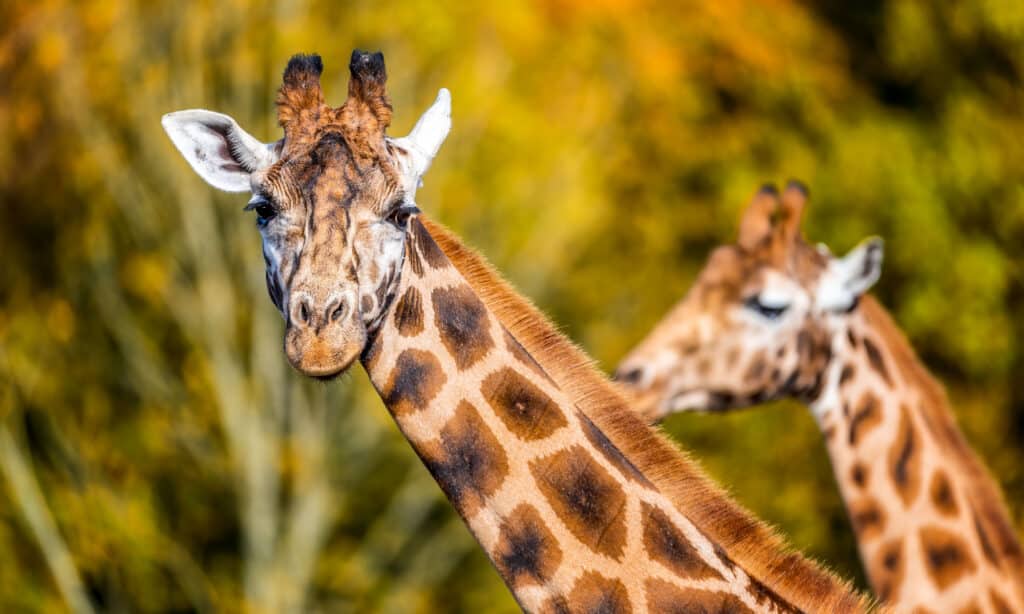
Giraffes
stretch from 14 to 19 feet tall and live about 25 years.
©Jane Rix/Shutterstock.com
Giraffa camelopardalis
These spotted mammals are the tallest animals on land. Giraffes stretch from 14 to 19 feet tall and live about 25 years. A giraffe’s legs alone are taller than most humans are – about 6 feet tall. Their long legs help them run up to speeds of over 35 miles an hour and cruise over short distances of 10 miles an hour. A giraffe’s spots are like human fingerprints because no two giraffes have the same pattern. The spots help giraffes to camouflage, but they also help regulate body temperature and help giraffes to be able to recognize each other. Under each patch or spot is a complex system of blood vessels, and research has even been conducted to show that the color of a male giraffe’s spot can determine his behavior.
3. Dalmations
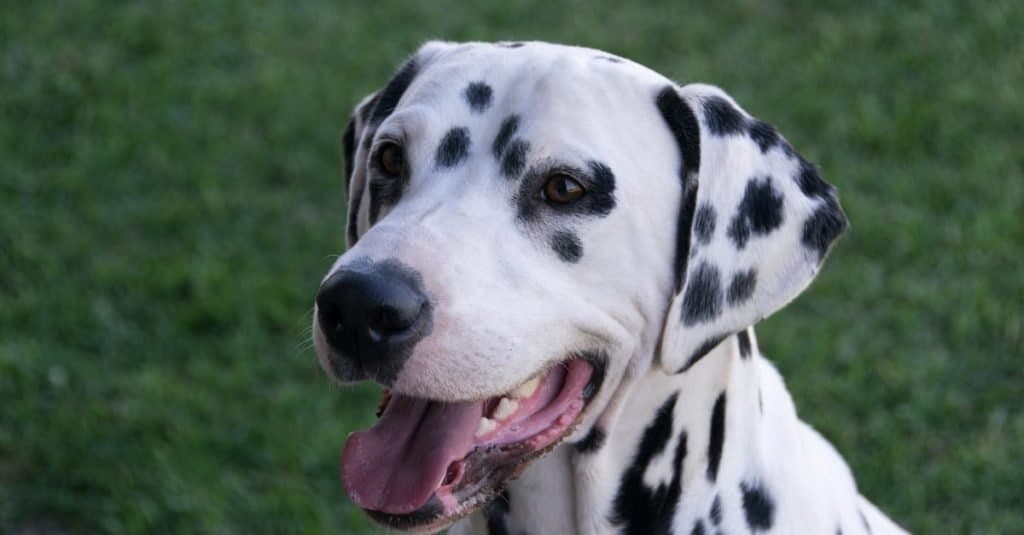
Dalmations are born solid white and don’t get their spots until they are two weeks old.
©Peter Wibberley/Shutterstock.com
Canis Lupis
Dalmations are a dog breed with a white coat marked with black or brown spots. Dalmatians originated a hunting dog, and the breed’s origins can be traced back to present-day Croatia in the historical region of Dalmatia. These dogs live for 12-14 years.
Dalmatian spots occur from the interaction of genes at several locations called loci. Loci is the fixed spot on a chromosome where a genetic marker is located. As a result, you will not find the Dalmatian coat pattern in any other dog breed. The spots vary in size from a dime to the extent of a half-dollar and are usually smaller on the head, legs, and tail than on the body. Ideally, the spots never intermingle. Fun fact: Dalmations are born solid white and don’t get their spots until they are two weeks old.
4. Cheetah

The cheetahs’ coat covered in their famous dark spots has a unique pattern to help animals identify one another.
©Stu Porter/Shutterstock.com
Acinonyx jubatus
These spotted mammals are the fastest animals on land and reach speeds of 60 miles an hour and sometimes 70. However, when cheetah chases their prey, they only chase them at half speed. Cheetahs are carnivores and live up to 14 years in the wild and 20 years in captivity. They weigh 77 to 143 pounds.
These cats’ bodies are uniquely adapted to help run at top speeds. Their long slender limbs, hard foot pads, and flexible spine give them long strides. This allows the cats to be agile at high rates and to hunt their prey quickly and suddenly. In addition, the cheetahs’ coat covered in their famous dark spots has a unique pattern to help animals identify one another. These cats can have up to 2000 spots on their body. Cheetahs usually live in open grasslands across eastern and southern Africa. However, cheetahs today are inching toward extinction due to loss of habitat and declining numbers of their prey combined to threaten the future of these cats.
5. Jaguars

Jaguars are solitary animals and spend most of their time alone.
©Pedro Helder Pinheiro/Shutterstock.com
Panthera onca
Jaguars are carnivorous animals that weigh 100 to 250 pounds. You will find these large cats in North, Central, and South America. Because they look so similar, jaguars and leopards get mistaken for each other. Their orange coats and black spots identify both of these cats. Jaguar spots are called rosettes as well, but the difference between jaguar spots and leopard spots is the fact that Jaguar rosettes have spots inside them. Jaguar spots are more complex and often have a dot in the center.
These cats have a rich history and were worshiped as gods in many South American cultures. In addition, representations of jaguars show up in the art of archaeology of pre-Columbian cultures across the Jaguar’s range.
Jaguars are solitary animals, spend most of their time alone, and are territorial. They define their territory as their own by their waste or clawing on trees. Female jaguars produce litters of one to four cubs. Jaguar cubs are blind and helpless at birth and need their mother to protect them for two years. After that, the mother will stay with the cus and defend them fiercely from any animal who comes near them, even their Father.
Jaguars used to roam freely through central Argentina all up to the southwestern part of the united states. However, more than half of the Jaguar’s territory has been lost due to habitat fragmentation. South and Central America’s high rates of deforestation for agriculture and grazing land have destroyed Jaguar’s habitat. Fragmented forests have caused the cats to be stuck in small patches of forest land, which has led to them being unable to find a mate or inbreeding.
6. Chital or Spotted Deer
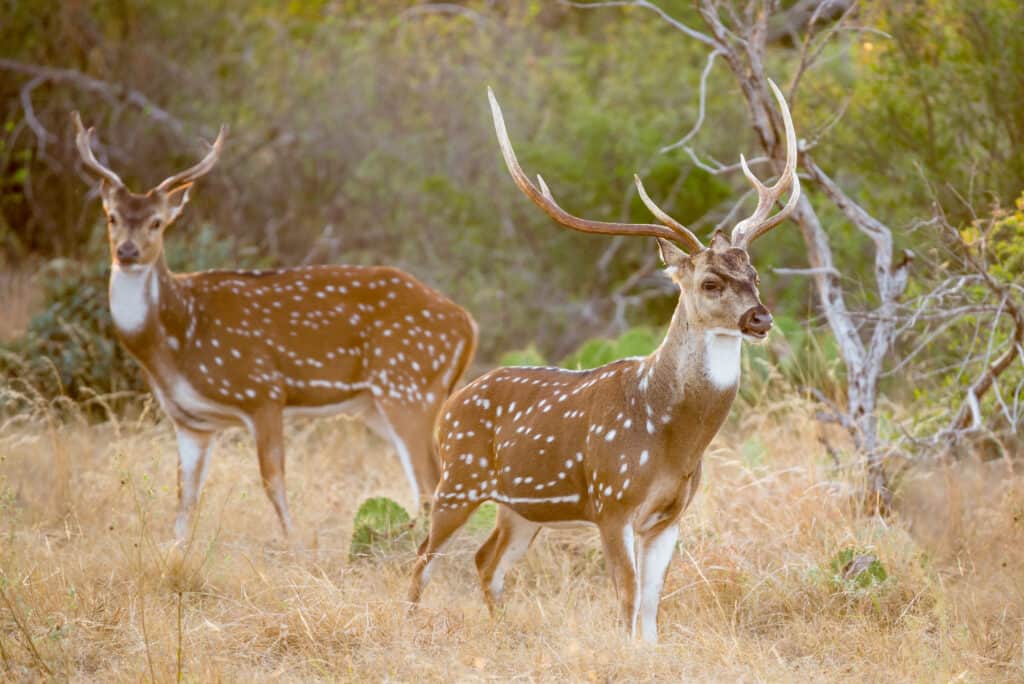
Wild South Texas Axis, Chital, or spotted Deer Buck.
©GizmoPhoto/Shutterstock.com
Axis axis
The spotted deer or chital is the most common deer species in Indian forests. They live between 20 and 30 years, and this deer is 35 inches tall and weighs 187 pounds. The chital, the Axis deer, is native to the Indian subcontinent. The upper golden-brown body of these beautiful deer is completely covered in white spots.
The chitals mating season is prolonged because the perpetually warm climate allows females to remain fertile and give birth to fawns anytime. Because these deer live in tropical conditions, males don’t have synchronized antler cycles. The size and hardness of a male’s antlers demonstrate their dominance.
These deer live and travel together in groups of hers consisting of 10 to 50 individuals. The herds consist of one or two males, the rest females, and the young.
7. The Spotted House Snake
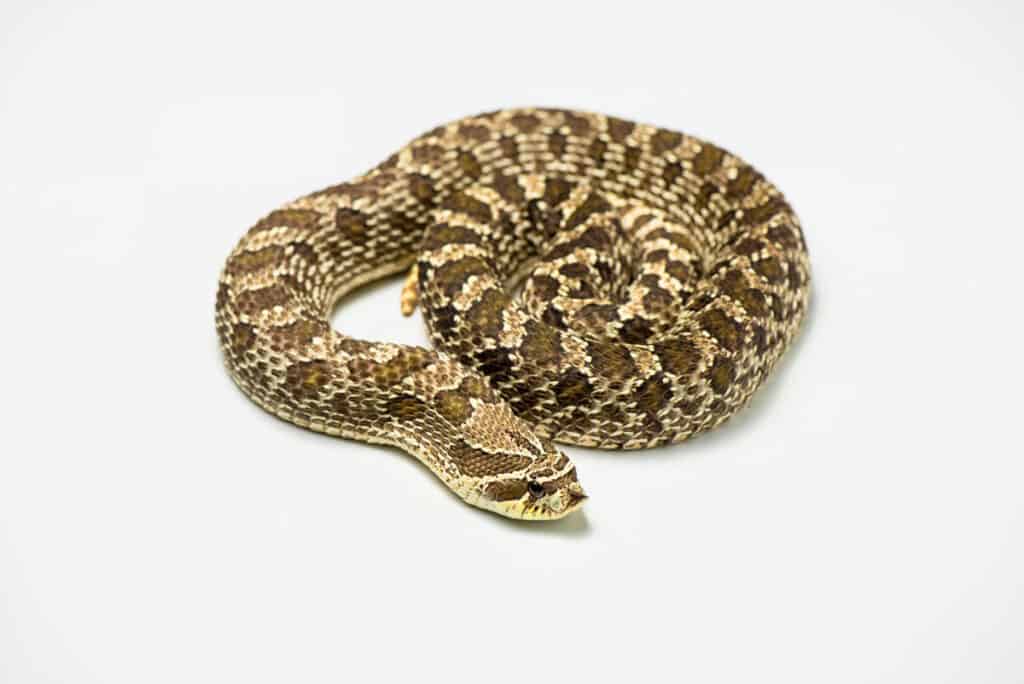
Jaguar morphs have a spotted pattern like the famous big cat they are named after.
©Peterpancake/Shutterstock.com
Lamprophis guttatus
There are several spotted varieties of snakes all over the world. For example, the spotted House Snake or the Spotted Rock Snake lives in the rocky terrain of South Africa. This snake is nocturnal and secretive as it hides between rocks to hunt its prey consisting of geckos, lizards, and occasionally small rodents. The snakes have brownish, tan, cream, or pink bodies with dark or red spots all over their body. These snakes grow between 16 and 24 inches and feature wide and flat heads to easily navigate through narrow rock crevices.
8. Holstein Friesian Cow
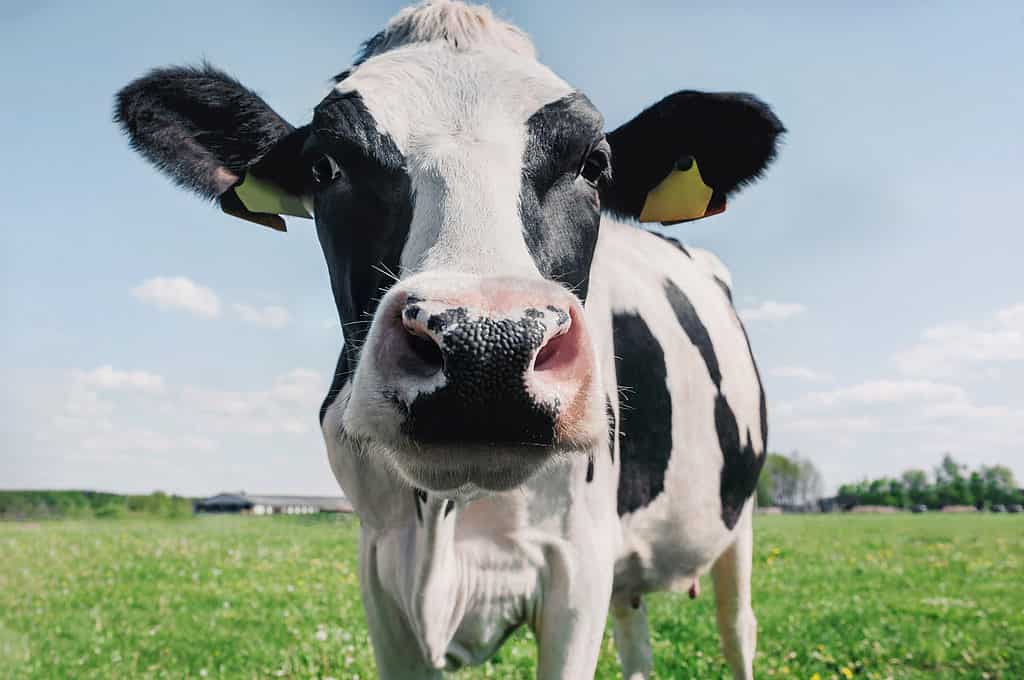
The Holstein Friesians outnumber all other dairy breeds, producing nine-tenths of the milk supply.
©Alena Demidyuk/Shutterstock.com
Bos taurus taurus
These breeds of cowards the black-and-white dairy cows. These cows originate from North Holland and Friesland. These cows are known for their beautiful and famous black spots and are the world’s highest dairy producers. No two cows have the same pattern, much like human fingerprints. Instead, these cows get their sites from the result of recessive genetics.
This cow’s chief characteristic is its large size. These cows are valued highly for their milk-producing ability. The Holstein Friesians outnumber all other dairy breeds, producing nine-tenths of the milk supply.
9. Appaloosa-Spotted Horse
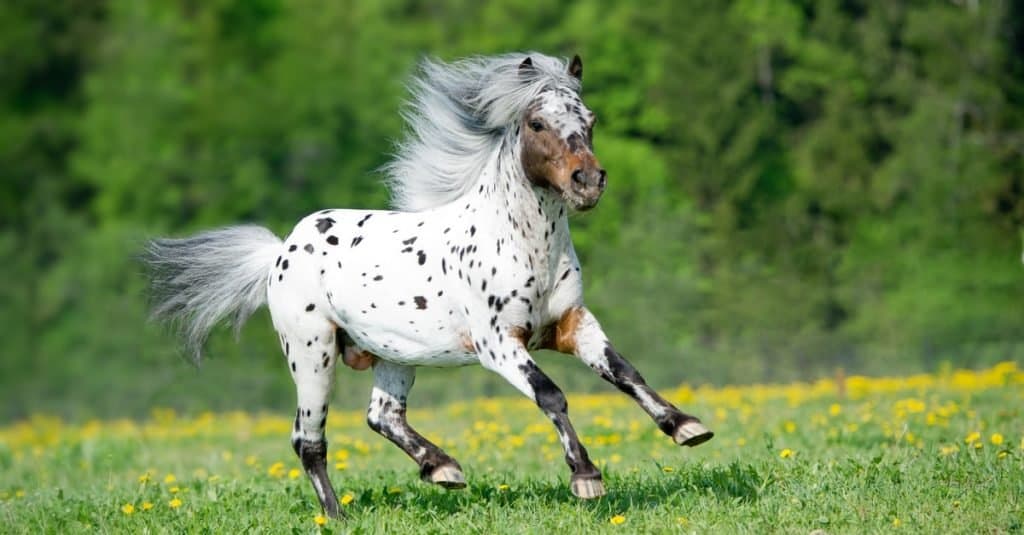
An Appaloosa horse gallops on a meadow in the summertime. The Appaloosa is an American horse breed best known for its colorful spotted coat pattern.
©olgaru79/Shutterstock.com
Equus ferus caballus
This spotted horse is native to America and is widely known for its distinctive spots. This horse breed is a hybrid species to generate multiple breeds of horses. These horses have a specific site like leopards, and spotting occurs in several overlay patterns and coat colors. These horses are used in riding disciplines like show jumping, fox hunting, and horse racing. Each horse’s color pattern is genetically the result of various spotting patterns overlaid on top of one of several base coat colors. The Appaloosa is one of the most famous horse breeds in the modern world. These horses participate in horseshoes around the globe.
10. Spotted Turtle
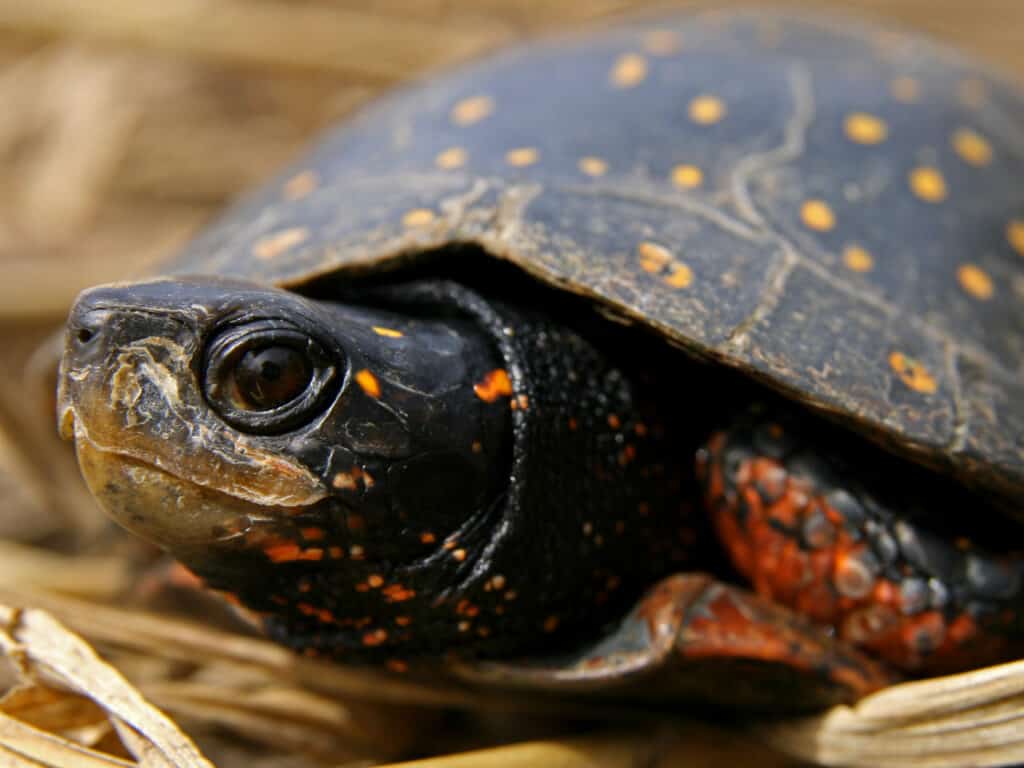
The spots cover the turtle’s shell and range in color from yellow and orange.
©Ryan M. Bolton/Shutterstock.com
Clemmys guttata
The spotted turtle species of the Clemmys characterizes as a small semi-aquatic turtle that reaches a carapace length of 8-12 cm upon adulthood. The spotted turtle only possesses one spot at birth but grows over 100 more as they become adults. The spots cover the turtle’s shell and range in color from yellow and orange. These polka-dotted creatures live along the East Coast but have declined in population.
11. Ocelot
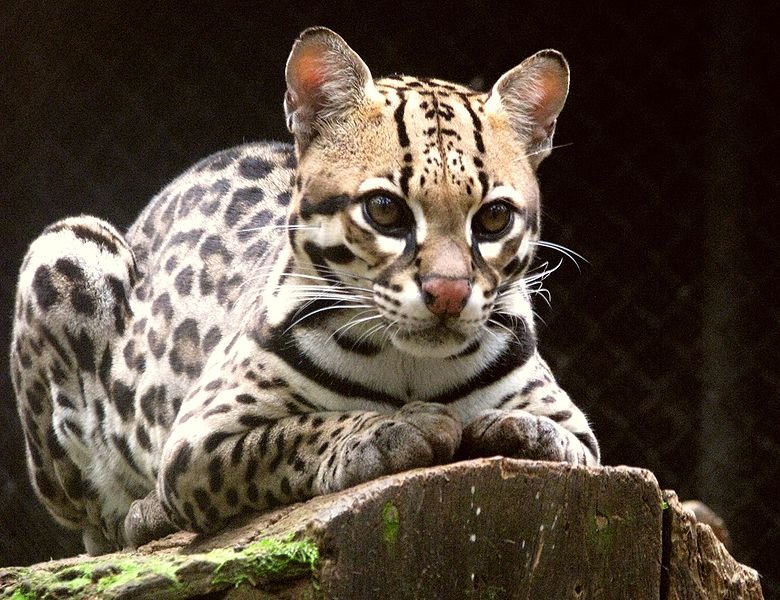
Ocelot (
Leopardus pardalis) also known as the Painted Leopard.
©Ana_Cotta, CC BY 2.0, via Wikimedia Commons – Original / License
Leopardus pardalis
This medium-sized cat reaches 40-50 cm at the shoulders and weighs, on average, between seven to 15.5 kg. They weigh 18-34 pounds and prefer to live near water sources with dense vegetation cover and high prey availability. This cat preys on small land mammals like armadillos, opossums, and lagomorphs. The ocelot, a solitary cat, hunts at twilight and night. The ocelot spots are also called rosettes, like the leopard and the cheetah.
The photo featured at the top of this post is © Dalmatiner24.eu - Public Domain
Thank you for reading! Have some feedback for us? Contact the AZ Animals editorial team.







